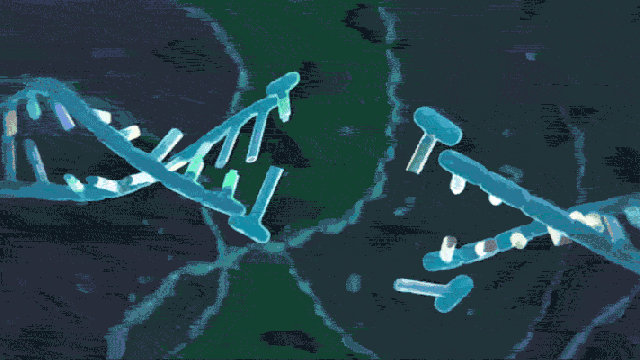This week, researchers at UCSF announced they’d uncovered a key to making their genetically-engineered creations a lot less likely to accidentally destroy the world: A way to turn-off modifications made with the powerful gene-editing technique CRISPR. Think of it like a kill-switch for genetic engineering.
IMAGE: Omar Bustamante//FUSION
CRISPR is often billed as the tool that turned genetic engineering into a simple act of “cutting and pasting” genes, but in truth it is not quite as sophisticated as that. CRISPR works by harnessing the immune system of bacteria that fight off invaders by copying little bits of viral DNA and incorporating them into its own genetic code, in order to better recognise a virus and attack it. By reprogramming that copy-and-paste function, scientists have achieved an unprecedented ability to decrypt and reorder genes. But this system doesn’t hit its target perfectly every time, meaning that sometimes scientists end up altering genes they didn’t mean to change.
There is great hope that CRISPR will allow scientists to treat cancers, design more efficient crops and one day perhaps even edit human embryos to reverse the course of fatal genetic disorders. But scientists and bioethicists also worry about how the technology might cause harm, either intentionally or accidentally. Right now, for example, scientists are exploring ways of using CRISPR to snip out the mutation that causes sickle-cell anaemia in blood cells. So far, the treatment has only been tested in mice. What if it proves to be effective in some people, but causes devastating side effects for others?
Traditional biosafety and biosecurity measures like physical containment don’t work for technologies meant to exist in the world we inhabit, technologies that solve the problems of our bodies and our environment. And CRISPR has made gene editing accessible not just to scientists, but to university students and random guys from Mississippi trying to genetically engineer their dogs. Given that cutting-edge genetic engineering technologies may soon become pervasive, scientists have been working on developing “reverse” mechanisms to prevent things from going awry.
In September, DARPA announced its Safe Genes program, which calls for research proposals to build a “biosafety and biosecurity toolkit” that can undo the effects of genetic engineering.
“We want ways to develop ways to control [gene edits], to turn them off and to actually remove them from the system,” the program manager, Renee Wegrzyn, told me at the time.
New research from UCSF that was published Thursday in Cell accomplishes part of that goal. Working with CRISPR-Cas9, the most widely used CRISPR bacterial system, researchers went hunting for an “anti-CRISPR” protein. In bacteria with immune systems that rely on CRISPR, the CRISPR system is the first line of defence, allowing the bacterium to quickly recognise an invading virus and then attack it. But sometimes a wily virus makes it through, incorporating itself into bacterial DNA. In those cases, the CRISPR system might force bacteria to begin attacking itself. But, the researchers reasoned, some bacteria must have a way of preventing this from happening.
Researchers found four so-called “anti-CRISPR” proteins, two of which seem to stop the CRISPR system from doing its thing in human cells, at least in a petri dish. They can’t undo an edit that’s already made, but the study suggests they could pull the plug on an edit that’s in progress.
The researchers hope to harness these anti-CRISPR proteins to improve the precision of CRISPR. Perhaps, for example, scientists could use both the CRISPR system and the anti-CRISPR proteins at once to ensure that only the correct cells wind up being modified. They also plan to keep searching for better CRISPR inhibitors, and for a better understanding of how those inhibitors actually work.
“Researchers and the public are reasonably concerned about CRISPR being so powerful that it potentially gets put to dangerous uses,” UCSF microbiologist Joseph Bondy-Denomy said in a statement, “These inhibitors provide a mechanism to block nefarious or out-of-control CRISPR applications, making it safer to explore all the ways this technology can be used to help people.”
Last month, researchers at the University of Toronto published findings on another set of proteins that seem to inhibit the CRISPR system in human cells. Other researchers have explored different avenues for making CRISPR more precise (and therefore, safer) including a “chemical switch” that only allows the system to function in the presence of a particular drug.
Gene drives, which rely on CRISPR to circumvent the traditional rules of inheritance, are one of the most promising (and terrifying) new genetic engineering methods for which scientists are anxious to find a reversal. Using CRISPR, scientists can “drive” a desired lab-engineered trait into all offspring in a population very quickly, overriding the 50-50 odds of genetic inheritance and even the force of natural selection. Theoretically, a gene drive could accidentally alter the genetic makeup of an entire species. To prevent this, scientists at MIT and Harvard have demonstrated in yeast that “molecular confinement” could work to stop a gene drive from spreading through a population.
Right now, there is still no CTRL-Z function for the genetic engineering tools of the future. But perhaps there will be, one day soon.
